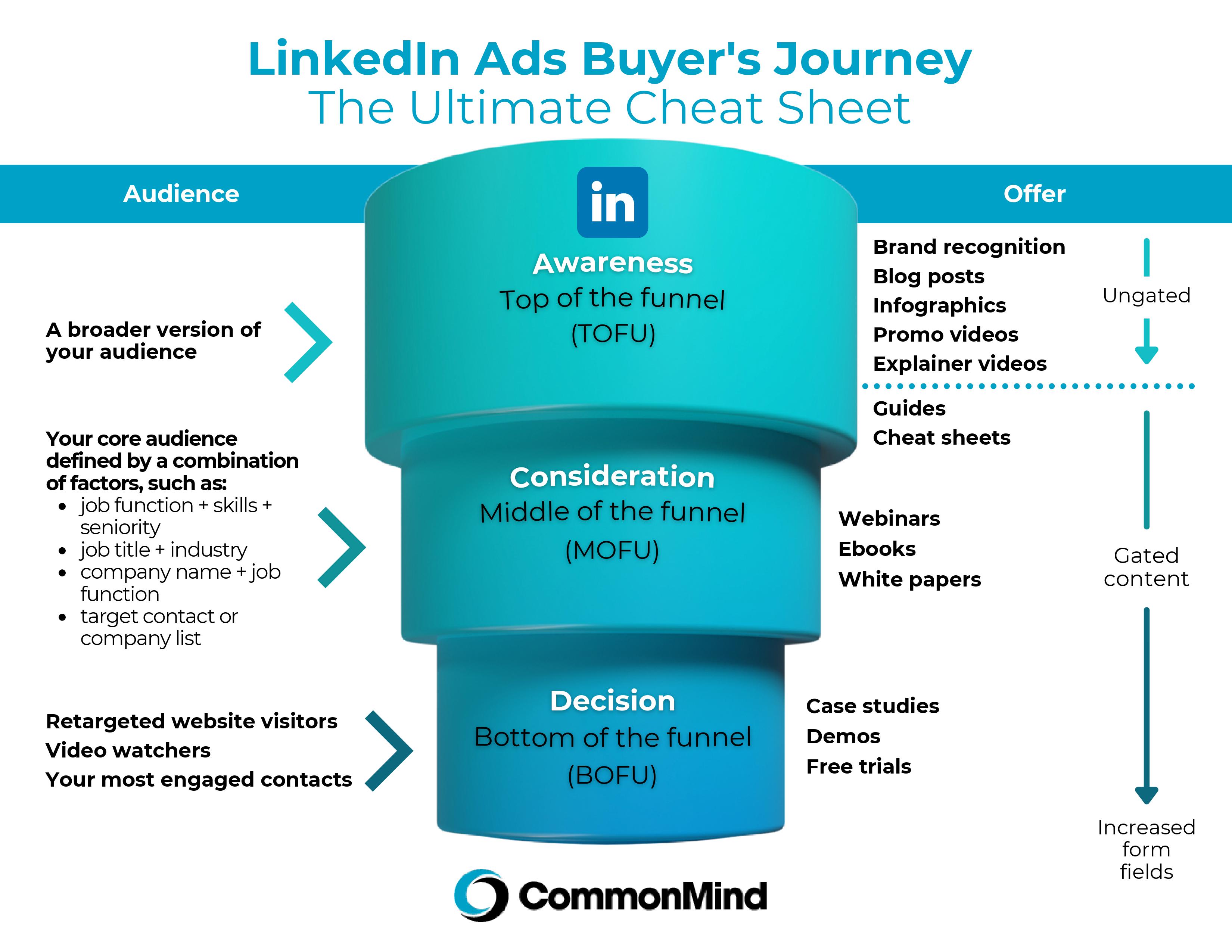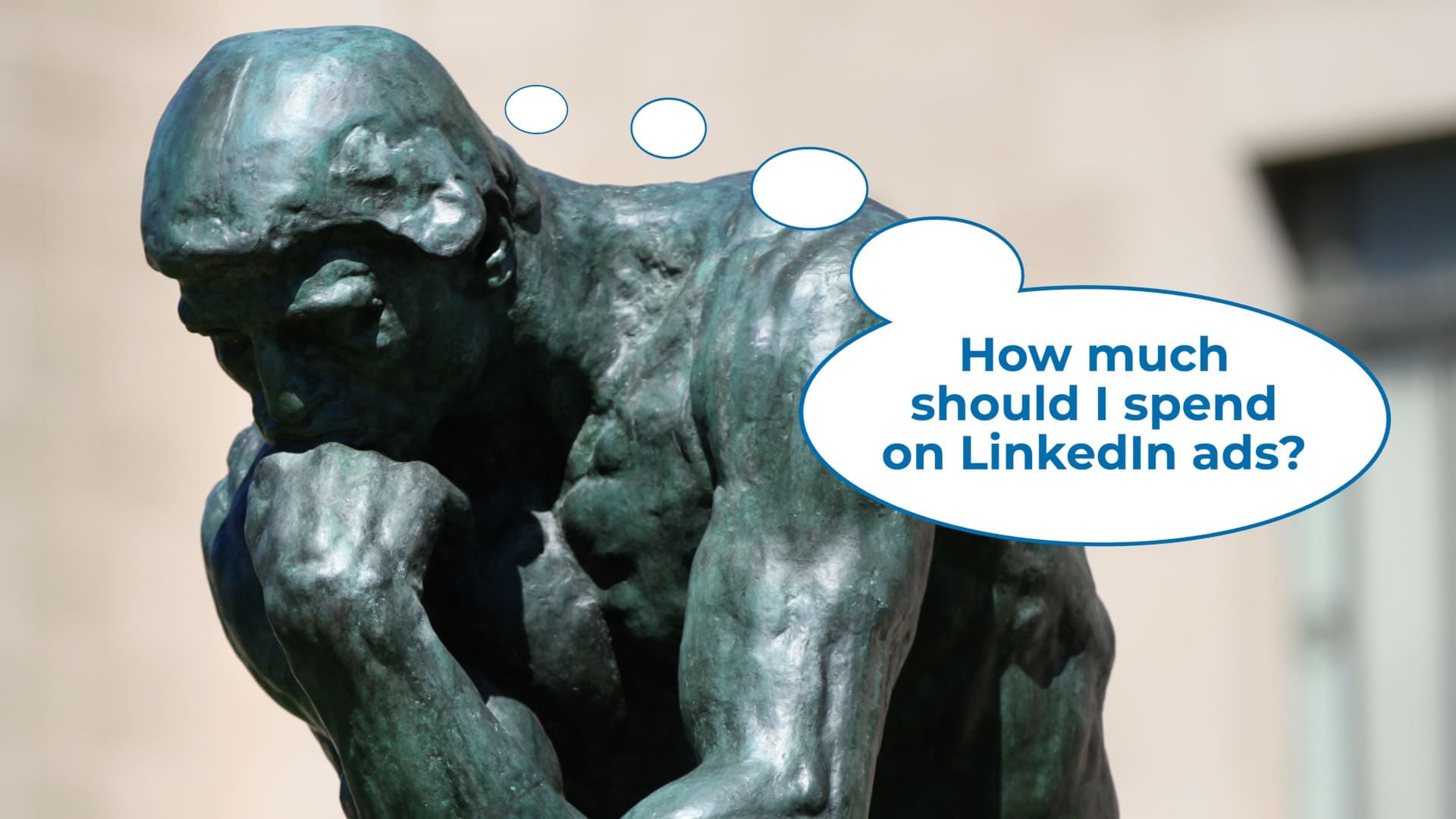When it comes to content offers, paying close attention to the buyer’s journey is crucial to success. LinkedIn ads are no different.
Even after you’ve managed to hone in on your ideal target audience on LinkedIn, you need to make sure that you’re promoting the right offers to the right people.
But how does this work with LinkedIn ads specifically?
Let’s talk about how the buyer’s journey factors into your offers on LinkedIn ads.
Awareness Stage Offers
During the awareness stage, the prospect is aware that they have a problem or a pain point. They’re likely looking for information on how to define their problem and approach it.
The awareness stage is often referred to as “Top of the Funnel” or “TOFU.”
Targeting for the awareness stage on LinkedIn involves taking a longer-term view of what to expect in return for your advertising. Rather than generating immediate leads, you’ll be building trust in your brand by providing helpful content to those who might be in the early stages of research and/or unfamiliar with your company.
For this reason, you may want to open up your targeting to include more junior seniority positions and companies that fall out of your ideal customer profile.
These individuals may not be decision-makers now, but they’ll certainly remember you later on if they benefit from helpful content produced by your brand today.
Also, people tend to switch jobs more frequently these days. For example, an IT specialist working for a company outside your target industries today might be an IT manager within one of your target industries in a year.
Here are a few staple content offers for the awareness stage:
- Blog posts – Blog posts are the quintessential TOFU content offer. There’s little friction for your audience to consume them, and users can get answers to their questions without being asked for anything in return, which helps build trust in your brand and expertise.
- Infographics – Infographics allow you to highlight otherwise dull data and statistics in an appealing way. Because they also tend to be quickly digestible, infographics are perfect for capturing the attention of busy users who would otherwise skip longer-form content.
- Videos – Although videos require more work upfront, users love video. According to Wyzowl’s State of Video Marketing Report, 94% of their survey respondents report watching explainer videos to learn more about a product, with 84% being swayed to make a purchase.
- Guides & Cheat Sheets – A short guide or cheat sheet is often a great way to provide definitions your prospect may need as they continue researching their problem, or step-by-step instructions on something specific. Aim for 1 – 2 pages. Anything longer gets into eBook territory.:
Consideration Stage Offers
The consideration stage is where prospects are fully aware of their problem and are actively seeking available solutions. They’re still looking for more information, but instead of trying to define their problem, they’re trying to understand some of the methods they can use to remedy the problem.
The consideration stage is also known as “Middle of the Funnel” or “MOFU.”
MOFU is the sweet spot for LinkedIn ads. Since potential buyers are seriously researching solutions to a problem they have identified, they’ll be more willing to engage deeply with your content.
Because of this, they’re also more likely to exchange their contact information for the content you create.
LinkedIn can be expensive. That’s why the tradeoff of providing premium content in exchange for contact information is where LinkedIn ads shine the brightest when it comes to your return on investment.
Valuable content offers you can use for consideration stage leads include:
- Webinars – A webinar gives you the perfect opportunity to connect with your audience beyond a simple pre-recorded video. For example, offering a Q&A session toward the end of the webinar to solve one-on-one problems and questions from specific individuals.
- eBooks – eBooks are great for demonstrating your expertise in any given field. They are typically more detail-heavy and visually appealing than blog posts.
- White papers – A white paper takes the depth of content further than an eBook, often including analytical data and more details. Be careful, though. White papers can ask a lot of your audience since they tend to be longer reads, so it’s essential to be clear with users about what they’ll be getting out of your white paper. Make your pitch both accurate and compelling.
All of these offers should be focused on providing value to your prospect and not be overly sales-focused. Content that simply tells the story about why you’re the best, and doesn’t provide valuable information and tips irrespective of your specific solution, can come across as an advertisement wrapped up as a content offer.
Decision Stage Offers
The final stage of the buyer’s journey is where prospects have decided which approach they will take. They’ve decided on a strategy to address their problem, but they’re actively evaluating competing products or potential service providers.
The decision stage is commonly known as “Bottom of the Funnel” or “BOFU.”
In regards to LinkedIn ads, your decision stage content should target your most engaged users. Typically, your most engaged users are those who meet one or more of these criteria:
- They already visited your website
- They watched a video about your brand
- They are on a target list that your marketing or sales team is reaching through other channels
All of these targeting options are conveniently available on LinkedIn.
Success with decision stage offers on LinkedIn depends on more than just the offer. You need to ensure that you’re using the right targeting options to reach those leads at the bottom of your funnel.
Some effective LinkedIn content offers for BOFU leads include:
- Case studies – Case studies can fit well as MOFU or BOFU content. However, we believe that they work best as BOFU/decision stage content. When a prospect is deciding between you and your competitors, they are most open to reading a case study to understand what sets you apart.
- Demos – Demos are a commonly-used BOFU content offer. They give you the chance to show off exactly what your product or service can do to help your audience.
- Free Trials – If your product or solution lends itself to free trials, they can be the perfect bottom of the funnel offer. At this stage, your prospect is likely deciding between you and your competitors. What better way to help them make that decision than giving them a taste of what your product can do?
LinkedIn Ads Are All About Promoting the Right Offer to the Right Audience
The bottom line is that while the offers you promote are important, who you’re promoting them to is also crucial.
Depending on where a lead is in the buyer’s journey, you’ll want to offer them appropriate content to help move them further down your funnel. Conversely, promoting offers to the wrong prospects can produce negative results. For example, promoting a case study to a prospect who is just starting to research their problem will likely lead to your offer being ignored and cost you money for ads without yielding a return.
LinkedIn comes with its own set of challenges and opportunities within the buyer’s journey. However, by following these tips, you’ll be well on your way to finding success with the offers you promote via LinkedIn ads.
Struggling With LinkedIn Ads? CommonMind Can Help
CommonMind can manage your LinkedIn ads strategy for you, ensuring that you’re promoting the right content to the right audience.
Reach out to us. We’d love to help.

Share this
You May Also Like
These Related Stories

How Much Should I Spend On LinkedIn Ads?

How Does LinkedIn Bill For Ads?
